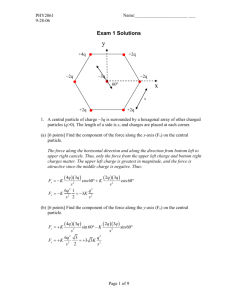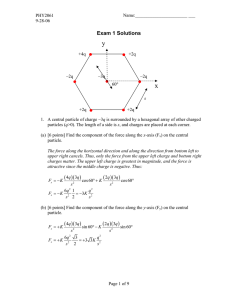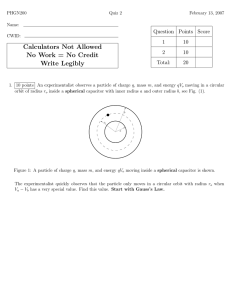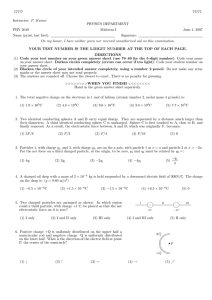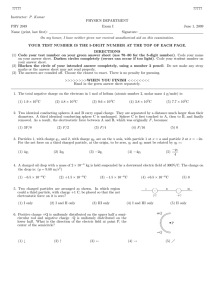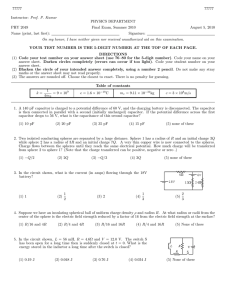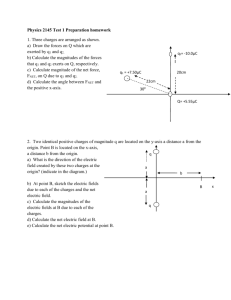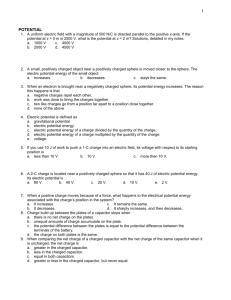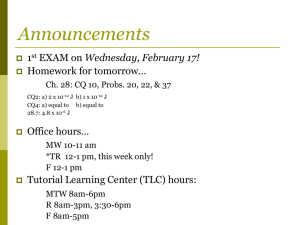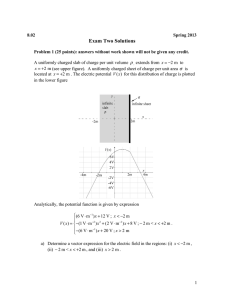Document 10437123
advertisement
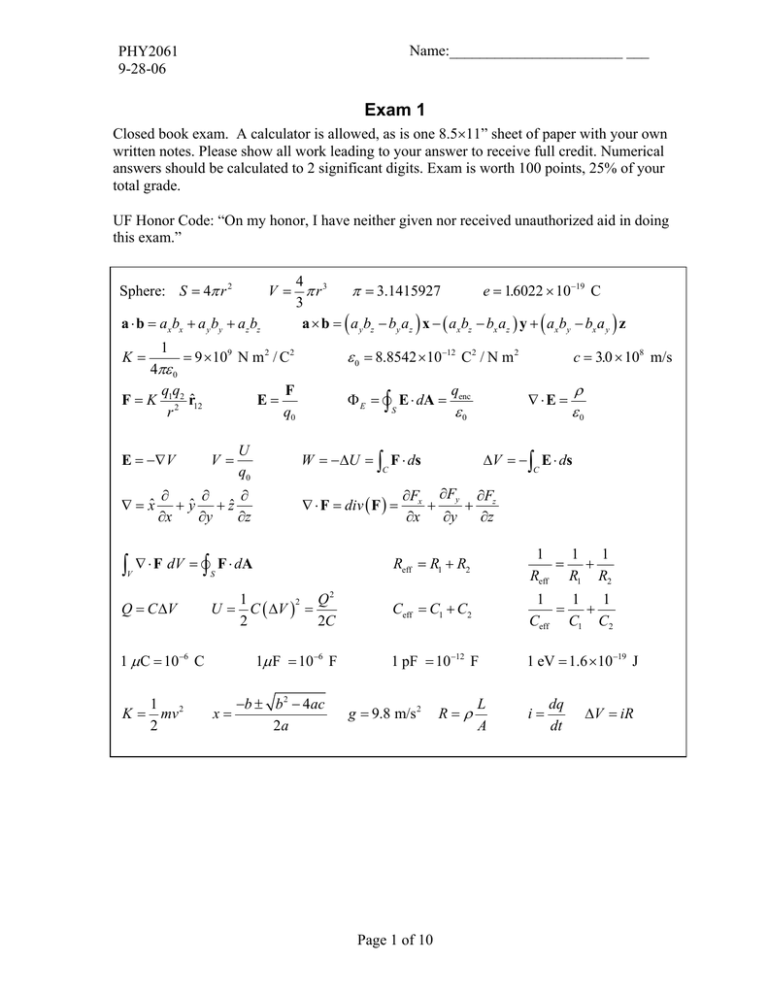
Name:_______________________ ___ PHY2061 9-28-06 Exam 1 Closed book exam. A calculator is allowed, as is one 8.5×11” sheet of paper with your own written notes. Please show all work leading to your answer to receive full credit. Numerical answers should be calculated to 2 significant digits. Exam is worth 100 points, 25% of your total grade. UF Honor Code: “On my honor, I have neither given nor received unauthorized aid in doing this exam.” 4 π = 3.1415927 e = 16022 . × 10−19 C V = π r3 3 a ⋅ b = ax bx + a y by + az bz a × b = ( a y bz − by az ) x − ( ax bz − bx az ) y + ( ax by − bx a y ) z Sphere: S = 4π r 2 1 K= 4πε 0 qq F = K 1 2 2 rˆ12 r E = −∇V ∇ = xˆ ∫ V ε 0 = 8.8542 ×10−12 C2 / N m 2 = 9 ×109 N m 2 / C 2 E= V= U q0 ∂ ∂ ∂ + yˆ + zˆ ∂x ∂y ∂z F q0 Φ E = v∫ Ε ⋅ dΑ = S K= 1 2 mv 2 ∇ ⋅ F = div ( F ) = 1 Q2 2 U = C ( ΔV ) = 2 2C 1μ F = 10−6 F x= ε0 −b ± b 2 − 4ac 2a ρ ε0 ΔV = − ∫ E ⋅ d s C S 1 μ C = 10−6 C ∇⋅E = W = −ΔU = ∫ F ⋅ ds ∇ ⋅ F dV = v∫ F ⋅ dΑ Q = C ΔV qenc c = 3.0 × 108 m/s C ∂Fx ∂Fy ∂Fz + + ∂x ∂y ∂z Reff = R1 + R2 1 1 1 = + Reff R1 R2 Ceff = C1 + C2 1 1 1 = + Ceff C1 C2 1 pF = 10−12 F 1 eV = 1.6 ×10−19 J g = 9.8 m/s 2 Page 1 of 10 R=ρ L A i= dq dt ΔV = iR Name:_______________________ ___ PHY2061 9-28-06 y +4q +2q −3q −2q −2q x s +2q +2q 1. A central particle of charge −3q is surrounded by a hexagonal array of other charged particles (q>0). The length of a side is s, and charges are placed at each corner. (a) [6 points] Find the component of the force along the x-axis (Fx) on the central particle. (b) [6 points] Find the component of the force along the y-axis (Fy) on the central particle. Page 2 of 10 Name:_______________________ ___ PHY2061 9-28-06 y +λ −λ R x 2. Consider electric charge distributed along a one-dimensional path in the form shown as two sections of ¼ of a circle each. The circle is centered at the origin with a radius of R, and the linear charge density is +λ in the left quadrant and −λ in the right. (a) [6 points] Find the component of the electric field along the x-axis (Ex) at the origin (0,0). (b) [6 points] Find the component of the electric field along the y-axis (Ey) at the origin (0,0). Page 3 of 10 Name:_______________________ ___ PHY2061 9-28-06 y x z 3. Consider a cube with side length s = 2 m and one corner at the origin (0,0,0) as shown. (a) [6 points] What is the total charge enclosed by the cube if the electric field is E = 3x 2 ˆi + 5ˆj − 2 z kˆ N/C ? ( ) (b) [6 points] What is the electric charge density (C/m3) at the center of the right face at x = 2 m if the electric field is the same as in part (a)? Page 4 of 10 Name:_______________________ ___ PHY2061 9-28-06 z R 4. [8 points] A flat nonconducting surface infinite in extent carries a uniform charge density of σ = 3 × 10−9 C/m 2 . A small circular hole of radius R = 1.5 m has been cut in the middle of the sheet as shown. Calculate the electric field at a point z = 5 m away from the center of the hole along an axis perpendicular to the surface. (In other words, consider z R , but don’t set R / z exactly equal to zero. You may find the superposition principle useful.) Page 5 of 10 Name:_______________________ ___ PHY2061 9-28-06 v + + + + + + + 5. [8 points] An electron is launched away from the surface of an infinite nonconducting sheet of charge with a velocity of v = 2 ×106 m/s on a trajectory perpendicular to the surface. The charge density of the sheet is σ = +5 nC/m2. Is the electron able to reach a distance infinitely far away from the charged sheet, and if not, how far does it travel before turning around? The charge of the electron is q = −e = −1.6 × 10−19 C , and the electron mass is me = 9.11×10−31 kg . Page 6 of 10 PHY2061 9-28-06 Name:_______________________ ___ 6. A conducting sphere of radius R1 contains a charge Q. It is surrounded by a concentric spherical conducting shell of radius R2 > R1 and charge −Q. (a) [6 points] What is the difference in electric potential between the shell and the sphere? (b) [6 points] What is the capacitance of the arrangement of conductors? Page 7 of 10 PHY2061 9-28-06 Name:_______________________ ___ 7. [6 points] Initially two electrons are fixed in place with a separation of 2.15 µm. How much work must be done to bring a third electron in from infinity to complete an equilateral triangle? 8. [6 points] Sketch the electric field lines for a negatively charged particle above the surface of a flat perfectly conducting surface (both above and below the surface). − conductor Page 8 of 10 PHY2061 9-28-06 Name:_______________________ ___ 9. A 1.5 µF capacitor is charged to a potential difference of 12 V, and the charging battery is disconnected. (a) [6 points] What is the energy stored in the capacitor? (b) [6 points] If the charged capacitor is then connected in parallel with a second (initially uncharged) capacitor, and if the potential difference across the first capacitor subsequently drops to 9 V, what is the capacitance of this second capacitor? Page 9 of 10 PHY2061 9-28-06 Name:_______________________ ___ 10. [6 points] The electric potential along the x-axis (in V) is plotted versus the value of x, (in cm). Evaluate the x-component of the electrical force (in Newtons, including sign) on a proton located on the x-axis at x = 10 cm. 11. [6 points] Two wires are made out of the same material (copper). One has a circular cross section with radius r = 1 mm and a length of 10 cm, the other has a square cross section with width s = 1 mm and a length of 5 cm. Which wire has the larger resistance? Page 10 of 10
